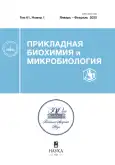New Features of Pectobacterium atrosepticum Virulence Factors
- Authors: Lomovatskaya L.A.1, Goncharova A.M.1
-
Affiliations:
- Siberian Institute of Plant Physiology, Biochemistry Siberian Branch of the Russian Academy of Science
- Issue: Vol 61, No 1 (2025)
- Pages: 100-106
- Section: Articles
- URL: https://journal-vniispk.ru/0555-1099/article/view/294564
- DOI: https://doi.org/10.31857/S0555109925010107
- EDN: https://elibrary.ru/DAITMM
- ID: 294564
Cite item
Abstract
The work analyzed nine strains of Pectobacterium atrosepticum (Pca) and obtained new information about the properties of the pathogen and the regulation of its main virulence factors. Anionic groups (PO34–) were identified in exopolysaccharides (EPS) of Pca, which differ in quantity among different strains and may contribute to the formation of denser biofilms. Most Pca strains inhibited the growth of potato plants in vitro to varying degrees, but one of them (strain 426) significantly activated this indicator in plants of the resistant potato variety Lugovskoy. Based on the totality of symptoms of the disease (chlorosis, necrosis, wilt, inhibition of growth rate), all strains of P. atrosepticum were divided according to the degree of virulence. In addition, it was shown that incubation of bacteria with a homogenate from potato plants in vitro modulated the activity of pectinase Pca: a homogenate from plants of the resistant potato variety Lugovskoy inhibited the activity of exopectinase, and from the susceptible variety Lugovskoy activated it. At the same time, the exopectinase activity of the avirulent strain 426 was inhibited to the greatest extent. It is assumed that this was the reason for stimulating the growth of potato plants in vitro of a resistant variety.
Full Text
About the authors
L. A. Lomovatskaya
Siberian Institute of Plant Physiology, Biochemistry Siberian Branch of the Russian Academy of Science
Author for correspondence.
Email: LidaL@sifibr.irk.ru
Russian Federation, Irkutsk, 664033
A. M. Goncharova
Siberian Institute of Plant Physiology, Biochemistry Siberian Branch of the Russian Academy of Science
Email: LidaL@sifibr.irk.ru
Russian Federation, Irkutsk, 664033
References
- Arif M., Czajkowski R., Chapman T.A. // Front. Plant Sci. 2022. V. 13. P. 1–4.
- Sledz M., Pomagruk A.M., Zukowska D., Wensierska W.B., Zoledowska S., Sledz E.L. // Eur. J. Plant Pathol 2023. V. 167. P. 99–121. https://doi.org/10.1007/s10658-023-02687-y
- Murata H.,Chatterjef A., Liu Y., Chatterjef A.K. // Appl. Environ. Microbiol 1994. V. 60. № 9. P. 3150–3159.
- Николайчик Е.А., Лагоненко А.Л., Валентович Л.Н., Лешкович И.И., Овчинникова Т.В., Присяжненко О.К. и др. // Вестник БГУ. 2006. Сер. 2. № 3. С. 32–37.
- Николайчик Е.А. // Труды БГУ. 2012. Т. 7. C. 43–55.
- Дюбо Ю.В., Николайчик Е.А. // Молекулярная и прикладная генетика. 2018. Т. 24. С. 37–43.
- Gorshkov V., Islamov B., Mikshina P.,Petrova O., Burygin G., Sigida E. et al. // Glycobiology. 2017. V. 27. № 11. Р. 1016–1026. https://doi.org/10.1093/glycob/cwx069
- Zheng C.,Wu W., Wu G.,Wang P. // Marine Drugs. 2022. V. 20. P. 512. https://doi.org/10.3390/md20080512.
- Луппа Х. Основы гистохимии. М.: Мир, 1980. 343 c.
- Ломоватская Л.А., Макарова Л.Е., Кузакова О.В., Романенко А.С., Гончарова А.М. // Прикл. биохимия и микробиология. 2016. Т. 52. № 3.С. 306–311. https://doi.org/10.7868/s0555109916030107
- Murashige T., Skoog F. // Physiol. Plant.1962. V. 15. P. 473–497.
- Вешняков В.А., Хабаров Ю.Г., Камакина Н.Д. // Химия растительного сырья. 2008. № 4. С. 47–50.
- Серегина Н.В., Честнова Т.В., Жеребцова В.А., Хромушин В.А. // Вестник новых медицинских технологий. 2008. Т. 15. № 3. С. 175–177.
- Николайчик Е.А, Овчинникова Т.В., Валентович Л.Н., Губич О.И., Шолух М.В., Евтушенков А.Н.// Доклады Национальной академии наук Беларуси. 2005. Т. 45. № 5. С. 81–85.
- Tsers I., Parfirova O., Moruzhenkova V., Petrova O., Gogoleva N., Vorob’ev V. et al. // Int. J. Mol. Sci. 2023. V. 24. P. 1–18. https://doi.org/10.3390/ijms241713283
- Islamov B., Petrova O., Mikshina P., Kadyirov A., Vorob’ev V., Gogolev Y., Gorshkov V. // Int. J. Mol. Sci. 2021. V. 22. P. 1–16. https://doi.org/10.3390/ijms222312781
- Karatan E., Watnick P. // Microbiol. Mol. Biol. Rev. 2009. V. 73. № 2. P. 310–347. https://doi.org/10.1128/MMBR.00041-0810.1128/MMBR.00041-08
- Ломоватская Л.А., Романенко А.С., Криволапова Н.В., Копытчук В.Н., Саляев Р.К. // Доклады Академии Наук. 2007. Т. 413. №. 3. С. 420–423.
- Indrayati A., Yurina V., Pitaya L.A., Retnoningrum D.S. // MicrobiologyIndonesia. 2011. V. 5. № 2. P. 88–93. https://doi.org/10.5454/mi.5.2.6
- Gorshkov V.Y., Daminova A.G., Mikshina P.V., Petrova O.E., Ageeva M.V., Salnikov V.V. et al. // Plant Biol. 2016. V. 4. P. 609–617. https://doi.org/10.1111/plb.12448
- Mallick T., Mishra R., Mohanty S., Joshi R.K. // Plant Рathol. J. 2022. V. 38..№ 2. P. 102–114. https://doi.org/10.5423/PPJ.OA.12.2021.0190
- Davidsson P.R., Kariola T., Niemi O., Palva E.T. // Front. Plant Sci. 2013. V. 4. Article 191. P. 1–13. https://doi.org/10.3389/fpls.2013.00191
- Agyemang P.A., Kabir Md.N., Kersey C.M., Dumenyo C.K. // Horticulturae. 2020. V. 6. P. 13. https://doi.org/10.3390/horticulturae6010013
- Joshi J.R., Paudel D., Eddy E., Charkowski A.O., Heuberger A.L // Front. Plant Sci. 2024. V. 15. https://doi.org/10.3389/fpls.2024.1336513
- Joshi J.R., Yao l., Charkowski A.O., Heuberger A.L. // Mol. Plant-Microbe Interactions. 2021. V. 34. № 1. P. 100–109. https://doi.org/10.1094/MPMI-08-20-0224-R
Supplementary files











